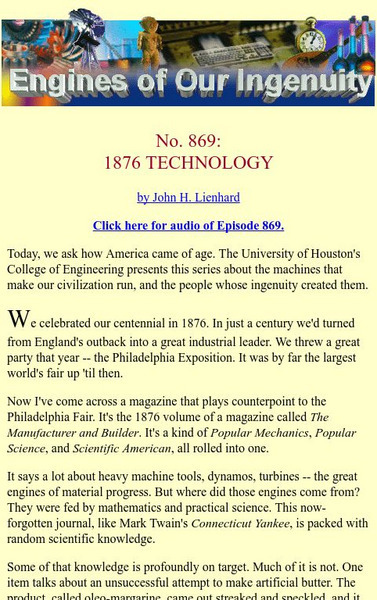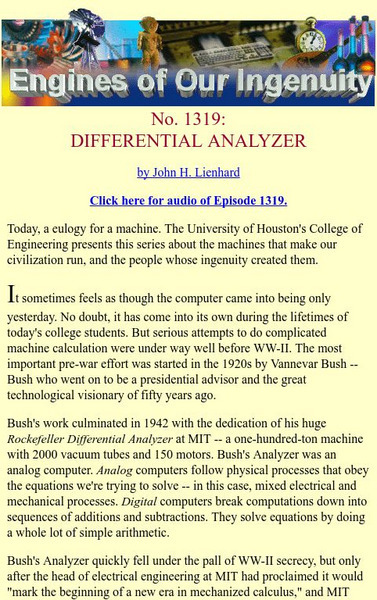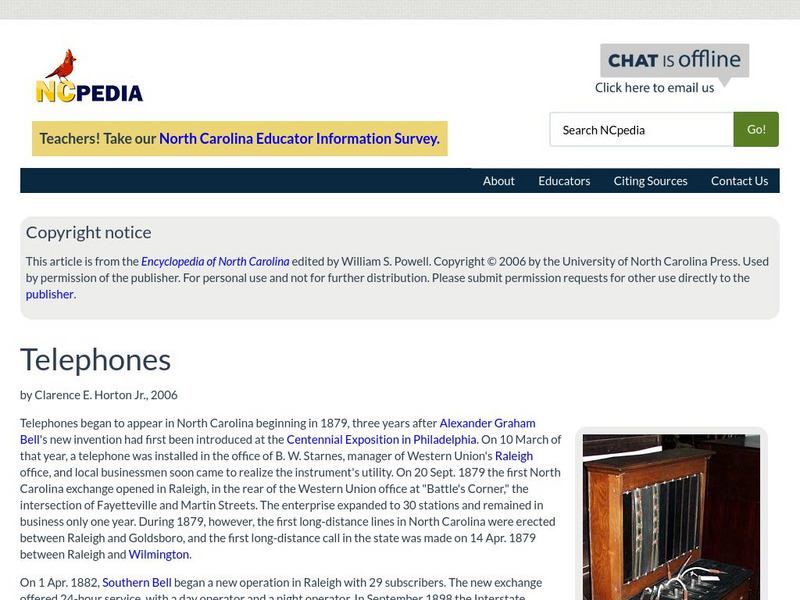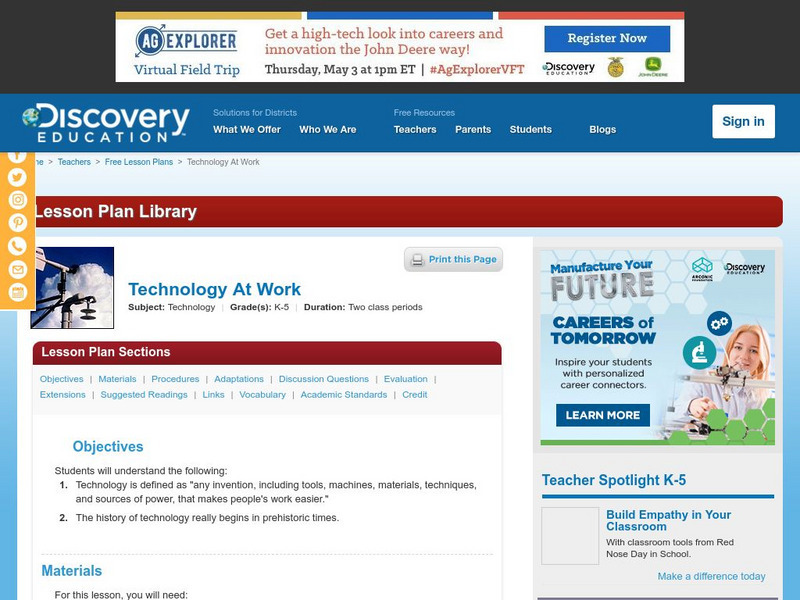Read Works
Read Works: Practice Makes Perfect
[Free Registration/Login Required] An informational text about creating or improving innovative products. A question sheet is available to help students build skills in reading comprehension.
South Carolina Educational Television
Etv: Nasa Online: Invention Process: Brain Teasers
Interactive brain games that challenge thinking and creativity skills.
Council for Economic Education
Econ Ed Link: Economic Spotter: Inventors and Entrepreneurs in the Industrial Age
The Industrial Age has also been called the Age of Edison. Edison patented more than 1000 inventions and gave rise to three industries: electric utilities, phonograph and record companies, and the film industry. This lesson will help...
Council for Economic Education
Econ Ed Link: Transportation: They Say We Had a Revolution (Part 1)
Advancements in transportation have played a key role in the growth of our nation. U.S.government policies have also had a considerable impact on the development of transport as we know it today. In this series of three lessons, the...
Council for Economic Education
Econ Ed Link: Transportation: They Say We Had a Revolution (Part 3)
Advancements in transportation have played a key role in the growth of our nation. U.S. government policies have also had a considerable impact on the development of transport as we know it today. In this series of three lessons, the...
Have Fun With History
Have Fun With History: Industrial Revolution
Multi media learning module with videos for students and teachers to learn about the Industrial Revolution and how America moved from and agricultural society to an urban machine-based production in the 19th Century.
Smithsonian Institution
Lemelson Center: Spark!lab: Create Indoor Kite [Pdf]
Learn how Ben Franklin, Alexander Graham Bell, the Wright Brothers, and Guglielmo Marconi used kites as tools to spur innovation. Then follow the directions provided to create your own kite for flying indoors.
PBS
Pbs Teachers:nordic Sagas: Viking Ships
Research Viking ship design and the technological innovations they invented to improve transportation. Construct a wind-powered model of a Viking ship and examine the relationship between rudder shape, placement and steering angle.
Great Idea Finder
The Great Idea Finder: Thomas Alva Edison
This site from The Great Idea Finder presents a lengthy biography of Thomas Edison, followed by a wealth of suggested resources including books, movies, and the Internet.
PBS
Pbs Kids: Martha Speaks: t.d. Reports: Chewing Gum
Take a walk through history with this kid-friendly, multimedia research report on the inventors of chewing gum.
Other
Business Insider: 20 Everyday Things We Have Because of Nasa
A list of space technologies that have been integrated into common items from invisible braces to memory foam. NASA produces a list like this every year to illustrate the benefits to the program's existence. Click on each item listed to...
Council for Economic Education
Econ Ed Link: Widget Production: Producing More Using Less
Through this economics lesson you will learn about widget production. One of the tasks is to see how productivity can help solve problems.
Library of Congress
Loc: Teachers: America at the Centennial
A lesson plan requiring student to analyze primary documents from the Philadelphia Centennial Exposition of 1876. Students interpret what these historical artifacts say "about the lives and values of Americans in 1876" among other things.
TED Talks
Ted: Ted Ed: Is There a Limit to Technological Progress?
Many generations have felt they've reached the pinnacle of technological advancement. Yet, if you look back 100 years, the technologies we take for granted today would seem like impossible magic. So- will there be a point where we reach...
Council for Economic Education
Econ Ed Link: National Council of Economic Education: Capital Chips
This site has a multi-part lesson that explores several aspects of productivity. The site incorporates online resources and activities.
University of Houston
University of Houston: Engines of Our Ingenuity: No. 869: 1876 Technology
Learn about the information that can be found in an 1876 issue of a magazine, The Manufacturer and Builder, about the tools, machines, and innovations of that era, including a reference to a young Thomas Edison. This is a transcript of a...
National Academy of Engineering
Greatest Achievements: Airplane
This page provides an overview of the history behind one of the greatest engineering innovations of all time:the airplane. There is also a timeline showing its development.
University of Houston
University of Houston: Engines of Our Ingenuity: No. 1319: Differential Analyzer
Read about the work of Vannevar Bush, who invented the differential analyzer, an analog computer. This is a transcript of a radio broadcast.
State Library of North Carolina
N Cpedia: Telephones
Telephones began to appear in North Carolina beginning in 1879, three years after Alexander Graham Bell's new invention had first been introduced at the Centennial Exposition in Philadelphia. On 10 March of that year, a telephone was...
Other
Creative Thinking With Thomas Edison
As a master inventor Thomas Edison used many techniques that helped him with his creative ideas. Learn how you can apply some of his techniques to yourself to aid you in your own creative inventiveness.
Khan Academy
Khan Academy: Crowdsourcing With a Global Crowd
Explore how crowdsourcing helps us to create common goods, invent new products, and make scientific discoveries.
Massachusetts Institute of Technology
Mit: Inventor of the Week: Percy Lavon Julian
Percy Lavon Julian is featured in this brief biography for his innovative contributions to medicine.
Discovery Education
Discovery Education: Technology at Work
In this classroom activity, students research the importance of technologies which contributed to societal advancements throughout history.
Smithsonian Institution
National Air and Space Museum: Wright Brothers: Embracing the Impossible [Pdf]
In this lesson, students explore primary resources to see what people who lived in the early age of flight felt about this innovation. They then compare that response to that towards an invention of today.

















